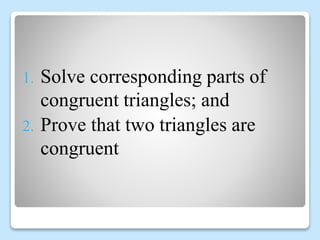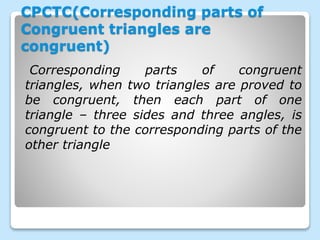CPCTC-lesson-17.1.pptx
- 1. CORRESPONDING PARTS OF CONGRUENT TRIANGLES ARE CONGRUENT
- 2. OBJECTIVE
- 3. 1. Solve corresponding parts of congruent triangles; and 2. Prove that two triangles are congruent
- 4. I AM EQUAL TO YOU
- 5. Given the ‚àÜùê¥ùêµùê∂ is congruent to ‚àÜùëÉùëÑùê∂, complete the following statements. B A C Q P
- 6. I. ùë®ùë© = ùë∑ùë∏ = ________ùíÑùíé B A C Q P
- 7. B A C Q P 6cm II. ùêÅùêÇ = ________ = ________ùíÑùíé
- 8. B A C Q P 5cm III. ùêÇùêè = ________ = ________ùíÑùíé
- 9. B A C Q P ùüëùüé¬∞ ùüèùüêùüé¬∞ ùüëùüé¬∞ IV. ‚à†ùë™ùë©ùë® = ________ = ________¬∞
- 10. Know me more!
- 11. CPCTC(Corresponding parts of Congruent triangles are congruent) Corresponding parts of congruent triangles, when two triangles are proved to be congruent, then each part of one triangle – three sides and three angles, is congruent to the corresponding parts of the other triangle
- 12. Given: ùêµùê∂ ‚âÖ ùê¥ùê∑, ùêµùê∂ ‚à• ùê¥ùê∑ Prove: ‚à†ùêµ ‚âÖ ‚à†ùê∑ Example 1 A B C D
- 13. Given: ùêµùê∂ ‚âÖ ùê¥ùê∑, ùêµùê∂ ‚à• ùê¥ùê∑ Prove: ‚à†ùêµ ‚âÖ ‚à†ùê∑ A B C D Statements Reasons 1. ùêÅùêÇ ‚âÖ ùêÄùêÉ, ùêÅùêÇ ‚à• ùêÄùêÉ 1. Given 2. ‚à†ùêÅùêÇùêÄ ‚âÖ ‚à†ùêÉùêÄùêÇ 2. Parallel ‚Äì Alternative Interior Angle Postulate 3. ùêÄùêÇ ‚âÖ ùêÄùêÇ 3. Reflexive Property of Congruence 4. ‚àÜùêÅùêÇùêÄ ‚âÖ ‚àÜùêÉùêÄùêÇ 4. SAS Postulate 5. : ‚à†ùêÅ ‚âÖ ‚à†ùêÉ 5. CPCTC
- 14. Given: ‚à†ùêµùê¥ùê∑ ‚âÖ ‚à†ùê∂ùê¥ùê∑,‚à†ùêµùê∑ùê¥ ‚âÖ ‚à†ùê∂ùê∑ùê¥ Prove: ùê¥ùêµ ‚âÖ ùê¥ùê∂ Example 2 A B D C
- 15. A B D C Given: ‚à†ùêµùê¥ùê∑ ‚âÖ ‚à†ùê∂ùê¥ùê∑,‚à†ùêµùê∑ùê¥ ‚âÖ ‚à†ùê∂ùê∑ùê¥ Prove: ùê¥ùêµ ‚âÖ ùê¥ùê∂ ùë∫ùíïùíÇùíïùíÜùíéùíÜùíèùíïùíî ùëπùíÜùíÇùíîùíêùíèùíî 1. ‚à†ùë©ùë®ùë´ ‚âÖ ‚à†ùë™ùë®ùë´ ‚à†ùë©ùë´ùë® ‚âÖ ‚à†ùë™ùë´ùë® Given 2. ùë®ùë´ ‚âÖ ùë®ùë´ Reflexive Property of Congruence 3. ‚àÜùë©ùë®ùë´ ‚âÖ ‚àÜùë™ùë®ùë´ ASA Postulate 4. ùë®ùë© ‚âÖ ùë®ùë™ CPCTC














